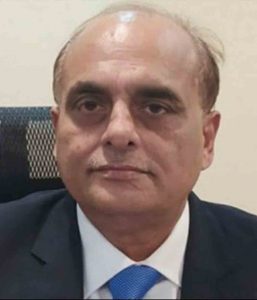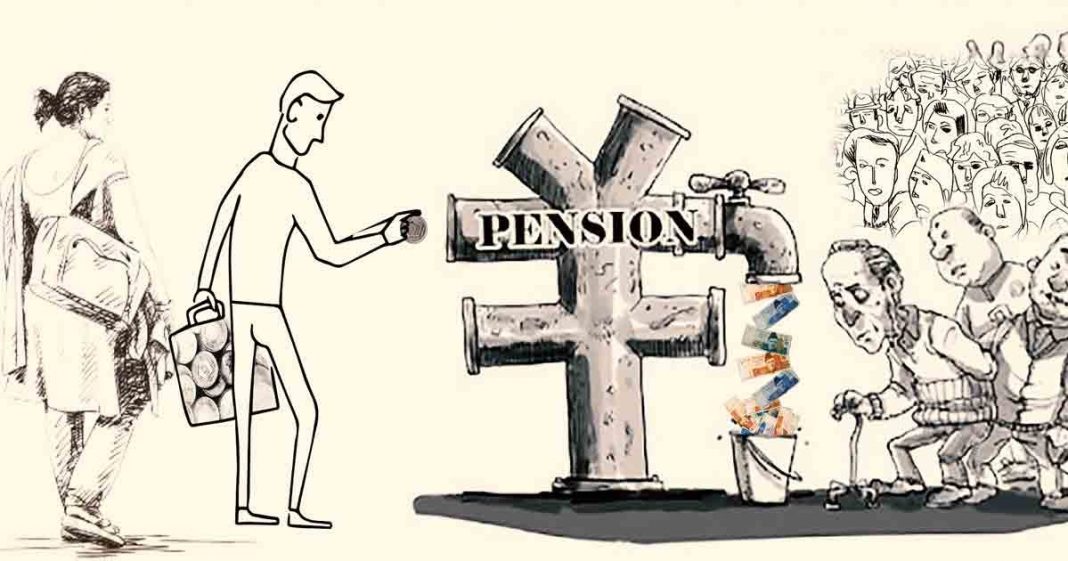In the last ten years, while Pakistan’s tax revenues increased by 2.7 times, the pension bill from the federal government, which includes military pensions (36 percent of the total
annual pension liabilities), increased by 5.2 times.
The local toll is said to be even higher, with numbers estimated at 7.1 times. Since 2013, numbers of government retirees have increased by 25 percent; however, the pension expense has increased by 432 percent from Rs 55 billion to Rs 238 billion.
This does not include pensions that the government is responsible to pay such as for those working in state owned enterprises or Pakistan Railways. Last year’s total pension liabilities of the federal and provincial governments claimed a quarter of revenues collected by FBR.
Pensions are an accepted tool to support people after their retirement. They are provided to those who retire after attaining a certain age or having completed their service period. The system has existed in one form or the other for centuries, initially adopted by armies to compensate soldiers and the wounded and act as an inducement for encouraging individuals to join military service.
The general concept of pensions originated later in the 19th century as militaries and government service employment expanded so did the pension base worldwide, later it was also introduced in the private sector.
However, as human longevity has increased, pensions have started to impinge on governments ability to afford them throughout the world. Furthermore, rising dependency ratios (larger numbers of those retiring being replaced by the fewer new entrants in the labor force) are stretching the ability of even western governments to sustain old age pension expenditures.
The drastic increase in the number of eligible public pension benefits has become a considerable challenge across the world. In Pakistan’s case, government pensions, while only benefiting a small segment of the population over time, are rising exponentially and have increasingly become unsustainable for the federal and provincial governments.
Read More: Taimur Jhagra explains everything wrong with the pension system of KP!
What makes them even more problematic is that they are pay as you go, defined pensions that the government funds from its current expenditure in the budget. Over the years, they are assuming a more significant proportion of that budget.
Pakistan is one of the few countries worldwide with a completely unfunded pension program. Furthermore, given the country always struggles to achieve its tax revenue targets, makes these pension payments even more troublesome.
Why the crisis?
The State Bank of Pakistan’s first quarterly report of the financial year 2020-21 has strongly urged pension reforms, highlighting that the overall pension spending as a share of tax
revenue has almost doubled over the last decade.
In this year’s budget, pension spending (excluding the entry: provision for pensions) will take up more than 8 percent of tax revenues. Pension expenditure already stands at close to being 80 percent of total PSDP expenditure.

Hasaan Khawar
Honorary fellow of Consortium
for Development Policy Research
“Pensions are growing at an exponential
speed and the way they are growing
they will soon totally eat away our
PSDP and development funds, it will
not leave us any space to do useful
work. It is the next circular debt issue
and it will be much bigger and not
as easy to resolve.”
Hasaan Khawar, warns that the current rate of growth in pensions (currently running at around Rs. 1 trillion) will squeeze out defense and development expenditures in the federal budget in the future; he estimated in a recent article that by 2050 it will hit 56 percent of all current spending if they continue growing at current rates. Actuarial estimates of future liabilities run in the trillions.
Why are we ignoring the pension crisis?
The pension crisis is hard to address due to complexities in the pension structure at federal and provincial levels and the political fallout from taking action. Governments have made huge numbers of political recruitments into both the government service and into state owned enterprises.
Federal pension payments comprise of military and civil pensioners. There is a larger share of military pensions in the federal pension budget because of earlier retirements in the army, which increases the duration of pension payments.
Increasingly, early retirements by civilian public sector employees have also built up expenditures as the current structure encourages people to retire well before 60, many often do so as early as 45 years, since it allows them to earn more from their pensions than the salary (thanks to a quirky rule introduced in 2009-10 that allows all earlier increases in pensions to be given to future retirees as well).
In addition, if someone joined the civil service in their 20s, then their 30 years of service would be complete before reaching the age of retirement, but given there are no extra benefits in terms of pension for continuing their service, they take early retirement.
Read More: Rise in pension expenditure has the SBP worried
Furthermore, younger age retirement allows them to enjoy a pension while getting another private sector position or other employment. The provision for family members to receive pension funding after the death of a retiree can prolong the payments for decades.
KP finance minister Taimur Jhagra shared information that, in some cases, it went down 13 layers of family hierarchy. Moreover, the unstructured approach for adjusting increments overcompensates the pensioners in real terms.
Unlike Pakistan, many countries use wages or CPI to adjust pension payments. In 2020, salaries and pensions were 25 percent of Punjab’s revenues, and according to a World Bank forecast, pensions will overtake wages by 2023 in the province.
Furthermore, Pensions in Punjab have been growing around 24 percent per annum, much bigger than the 13 percent growth expected in revenues. Ad hoc allowances and higher replacement rates are also building up the pension costs for the province.
In Punjab, pension expense to revenue increased from 6.75 percent in FY 2010-11 to 16.25 percent in FY 2019-20. Moreover, pensions have been often grown at a higher rate than inflation, which is also unsustainable as pointed out by the Punjab government’s White Paper itself that “annual increase in pension should not be higher than the annual inflation rate.”
The government launched the General Provident Fund a few years ago, but the results have not been promising so far. It requires more contributions from employees and better management from an investment point of view.
Recently, the Khyber-Pakhtunkhwa government issued a White Paper (FY 2021-22) that recognized the enormity of the issue in which “salaries and pensions have been growing at compounded annual rate of around 22 percent and 14.5 percent respectively while in the same period the receipts grew by 8.1 percent only.
Read More: Pensions: A brewing disaster
With this trend continuing, salaries and pensions will surpass the provincial receipts.” Taimur Jhagra, KP finance minister, shared scary numbers on the pension issue for the province. Over the last 17 years, pensions as a percentage of the provincial budget for the KP province have gone up from 1.13 percent to 13.4 percent in the outgoing fiscal year 2020-21(FY21). The pension expenditure increased 95 times from costing Rs. 0.87 billion in 2003-04 to Rs. 83.1 billion in FY21.

Shahid Sattar
Executive Director & Secretary
General of APTMA
“The hidden pension liability of the
State runs into many trillions and is
a ticking time bomb much more lethal
than circular debt. The government
is paralyzed as the magnitude of the
problem is overwhelming and it has
adopted an ostrich like approach.
All employment henceforth has to
be based on contributory pensions.
No exceptions.”
Way forward
Hasaan Khawar points out there is no one-time fix for the problem. Governments have to work on it in the long run over the next couple of decades. This also means no government
is interested in tackling it.
Many countries have long moved towards the defined contribution mechanism. This means a percentage of income is taken from the employee, which is often matched by the employer and is invested to earn returns over time, covering pension costs.
Pakistan needs to move towards this system as a matter of urgency. India, which used to have the same type of system as Pakistan, began exploring an alternative approach in the 1990s to reduce the cost of its civil service pension payments, and in 2004 the National Pension System became operational.
It is a funded defined-contribution scheme that is compulsory for government employees who joined after 2004. In 2009, the private sector was also allowed to contribute to it. For Pakistan low lying fruit for reform includes removing the provision for families to inherit pensions after the retired employee’s death; in some cases, the government continues to pay the pension for decades after the actual employee has died.
Pension increases should be indexed to the consumer price index and not as currently randomly decided by governments. Recruitment in government jobs – especially below grade 17 – need to be immediately halted except on an emergency basis until the issue has been resolved.
Hasaan Khawar also suggests that any future government recruitment needs to be done on a defined contribution basis so that all future pension liabilities are funded. This is the easiest way to start the process and then existing employees can be shifted over time to this system also.
Read More: Pakistan’s Unsustainable Pension Bomb
Early age retirement should be discouraged, including not giving pension until a certain defined age despite early retirement as done by many private pension plans worldwide. As far back as 2003, the Pension Review Working Group and later in 2008, the National Commission on Government Reforms recommended that the government move over to a funded pension scheme with defined contributions by the employees, but subsequent governments have not shown the political will to undertake the reform.
The current PTI government is talking about addressing this issue. Last year, Prime Minister Imran Khan stated that the pension issue must be resolved as the situation is becoming unsustainable.
However, despite a pay and pension commission also set up by the PTI government not much has come out of it so far; an overhaul of the system is seen to be very risky politically, so gradual measures, if any, at a tortoise pace are likely to be initiated in the years to come.
Having said that, to address this situation, the KP government has very recently taken several measures, including the increase in minimum voluntary retirement age (from 45 to 55), rationalizing the number of beneficiaries to disallow multiple pensioners (now only widow, dependent children, and parents to be allowed), an amendment in KP Civil Service Act is underway which will further change the nature of the pension scheme and make all new government employees contribute to pension programs.
The data suggests that federal and provincial governments have a tough challenge and are running short on time. Ad hoc measures will make the long-term situation more unsustainable, and throw the issue down the road.
We need to run actuarial estimates to understand how much we owe and how much accrued liability has to be paid off otherwise it will explode and will become impossible for future governments to manage, so consistent and evidence-backed changes are needed to rescue the country from this ticking bomb.














